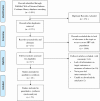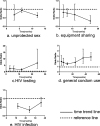Peer education for HIV prevention among high-risk groups: a systematic review and meta-analysis
- PMID: 32398032
- PMCID: PMC7218508
- DOI: 10.1186/s12879-020-05003-9
Peer education for HIV prevention among high-risk groups: a systematic review and meta-analysis
Abstract
Background: Peer education has become a strategy for health promotion among high-risk groups for HIV infection worldwide. However, the extent to which peer education could have an impact on HIV prevention or the long-term effect of this impact is still unknown. This study thus quantifies the impact of peer education over time among high-risk HIV groups globally.
Method: Following the PRISMA guidelines, a systematic review and meta-analysis was used to assess the effects and duration of peer education. A thorough literature search of PubMed, Web of Science, Embase and Cochrane Library was performed, and studies about peer education on high-risk HIV groups were reviewed. Pooled effects were calculated and the sources of heterogeneity were explored using meta-regression and subgroup analysis.
Results: A total of 60 articles with 96,484 subjects were identified, and peer education was associated with 36% decreased rates of HIV infection among overall high risk groups (OR: 0.64; 95%CI: 0.47-0.87). Peer education can promote HIV testing (OR = 3.19; 95%CI:2.13,4.79) and condom use (OR = 2.66, 95% CI: 2.11-3.36) while reduce equipment sharing (OR = 0.50; 95%CI:0.33,0.75) and unprotected sex (OR = 0.82; 95%CI: 0.72-0.94). Time trend analysis revealed that peer education had a consistent effect on behavior change for over 24 months and the different follow-up times were a source of heterogeneity.
Conclusion: Our study shows that peer education is an effective tool with long-term impact for behavior change among high-risk HIV groups worldwide. Low and middle-income countries are encouraged to conduct large-scale peer education.
Keywords: High risk HIV groups; Meta-analysis; Peer education.
Conflict of interest statement
The authors declare that they have no competing interests.
Figures







Similar articles
-
Outcomes of an AIDS prevention program for methadone patients.Int J Addict. 1991 Jun;26(6):629-55. doi: 10.3109/10826089109058910. Int J Addict. 1991. PMID: 1757169
-
Evaluation of a targeted AIDS prevention intervention to increase condom use among prostitutes in Ghana.AIDS. 1994 Feb;8(2):239-46. doi: 10.1097/00002030-199402000-00012. AIDS. 1994. PMID: 8043229
-
Is AIDS education related to condom acquisition?Clin Pediatr (Phila). 1992 Apr;31(4):205-10. doi: 10.1177/000992289203100403. Clin Pediatr (Phila). 1992. PMID: 1563193 Clinical Trial.
-
Prostitutes: a high risk group for HIV infection?Soz Praventivmed. 1988;33(7):336-9. doi: 10.1007/BF02084300. Soz Praventivmed. 1988. PMID: 3066058 Review.
-
Peer Education and Peer Counselling for Health and Well-Being: A Review of Reviews.Int J Environ Res Public Health. 2022 May 17;19(10):6064. doi: 10.3390/ijerph19106064. Int J Environ Res Public Health. 2022. PMID: 35627601 Free PMC article. Review.
Cited by
-
Experiences of recently HIV-diagnosed gay and bisexual migrants in Australia: Implications for sexual health programmes and health promotion.Health Soc Care Community. 2022 Nov;30(6):e5801-e5810. doi: 10.1111/hsc.14011. Epub 2022 Sep 15. Health Soc Care Community. 2022. PMID: 36107017 Free PMC article.
-
An evaluation of StaySafe, a tablet app to improve health risk decision-making among people under community supervision.J Subst Abuse Treat. 2021 Nov;130:108480. doi: 10.1016/j.jsat.2021.108480. Epub 2021 May 14. J Subst Abuse Treat. 2021. PMID: 34118712 Free PMC article.
-
Current Resources for Evidence-Based Practice, November 2020.J Obstet Gynecol Neonatal Nurs. 2020 Nov;49(6):605-619. doi: 10.1016/j.jogn.2020.10.001. Epub 2020 Oct 21. J Obstet Gynecol Neonatal Nurs. 2020. PMID: 33096044 Free PMC article.
-
Evidence and gap map report: Social and Behavior Change Communication (SBCC) interventions for strengthening HIV prevention and research among adolescent girls and young women (AGYW) in low- and middle-income countries (LMICs).Campbell Syst Rev. 2023 Jan 10;19(1):e1297. doi: 10.1002/cl2.1297. eCollection 2023 Mar. Campbell Syst Rev. 2023. PMID: 36911864 Free PMC article.
-
Peer interventions to improve HIV testing uptake among immigrants: A realist review.Health Promot Perspect. 2024 Mar 14;14(1):19-31. doi: 10.34172/hpp.42639. eCollection 2024 Mar. Health Promot Perspect. 2024. PMID: 38623348 Free PMC article. Review.
References
-
- Solomon SS, Solomon S, McFall AM, Srikrishnan AK, Anand S, Verma V, Vasudevan CK, Balakrishnan P, Ogburn EL, Moulton LH, et al. Integrated HIV testing, prevention, and treatment intervention for key populations in India: a cluster-randomised trial. Lancet Hiv. 2019;6(5):e283–e296. doi: 10.1016/S2352-3018(19)30034-7. - DOI - PMC - PubMed
-
- Global HIV & AIDS statistics-2019 fact sheet. https://www.unaids.org/en/resources/fact-sheet. Accessed 15 Feb 2020..
Publication types
MeSH terms
Grants and funding
LinkOut - more resources
Full Text Sources
Medical

